In it, Little Rock Mayor Mark Stodola is quoted:
"Little Rock Mayor Mark Stodola says the trail is technically complete, though not optimal.
“We've got some physical and geographical obstacles there,” Stodola says. “Nothing on this project has been easy. It's all been a challenge, but we're going to get it done.”
The Mayor doesn't ride much, obviously...
The problem with the River Trail crossing Cantrell/LaHarpe in front of the Episcopal School is a lot more than just an issue for “recreational” cyclists, because the trail and streets are used for much, much more than just recreation. A significant number of people depend on bicycles as their main transportation to get to work, or otherwise get around town. Ever look behind the various restaurants and hotels around the River Market area and see all the bikes parked there? They belong to the employees who work in those businesses. The River Trail and adjoining/connected streets are an important means for them to get to work, or wherever else they have to go.
A second issue is that the closure of North Street with no other street access between the Junior Deputy Park area and the other side of the railroad tracks near Cross Street completely severs the River Trail, and blows a big honking gap into what has become a major attraction for the city and county. All the millions of dollars spent on the Big Dam Bridge? Think about it… with the loss of connectivity east and west of Cantrell/LaHarpe, what are you going to do when you see this sign down there…
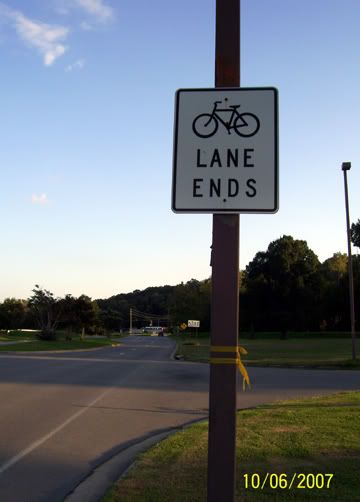
… turn around and go home?
The third issue is compliance with the state and city traffic codes. Arkansas law (A.C.A. Sec. 27-49-111) states that “Every person riding a bicycle or an animal, or driving any animal drawing a vehicle upon a highway, shall have all the rights and all of the duties applicable to the driver of a vehicle, except those provisions of this act which by their nature can have no applicability." As a cyclist, when you ride on the public roads and streets, you're subject to the same traffic laws as the operator of any other vehicle. John Forester (Effective Cycling, 1976) has distilled this down to what is referred to as the "vehicular cycling principle,"Cyclists fare best when they act and are treated as drivers of vehicles."
Little Rock has a number of city ordinances which are more stringent for cyclists. First of all, Ordinance 32-487 reinforces the state law directing compliance with traffic signals and signs, to include things like stop signs, one-way streets and lanes, and “Do Not Enter” signs:
Sec. 32-487. Obedience to traffic-control devices.
Any person operating a bicycle shall obey the instructions of official
traffic-control signals, signs, and other control devices applicable to
vehicles, unless otherwise directed by a police officer. Whenever authorized signs are erected indicating that no right or left or U-turn is permitted, no person operating a bicycle shall disobey the direction of any such sign, except where such person dismounts from the bicycle to make any such turn, in which event such person shall then obey the regulations applicable to pedestrians.
Ordinance 32-489 establishes a mandatory bike lane rule… if there’s a marked bike lane, cyclists are required to use that lane instead of the rest of the street. So, you have to follow the bike path, wherever it leads, in order to be "street legal":
Sec. 32-489. Riding on roadways and bicycle paths.
Every person operating a bicycle upon a roadway shall ride as near as to the right-hand side of the roadway as practicable, exercising due care when passing a standing vehicle or one proceeding in the same direction. Persons riding bicycles upon a roadway shall not ride more than two (2) abreast except on paths or parts of roadways set aside for the exclusive use of bicycles. Whenever a usable path for bicycles has been provided adjacent to a roadway bicycle riders shall use such path and shall not use the roadway.
(This MBL ordinance, by the way, along with the current problem with the Trail crossing Cantrell, is a factor that will work strongly against Little Rock’s petition to be designated as a Bicycle-Friendly Community.)
And while State law is silent upon the issue of riding on sidewalks (meaning that where not specifically prohibited by a city ordinance, you can ride your bike or even drive your car on the sidewalks in Arkansas), Ordinance 32-494 specifically prohibits riding bikes on the sidewalk in the business district and downtown area, with the exception of the City Police Dept.’s bike patrols):
Sec. 32-494. Riding on sidewalks.
No person shall ride a bicycle upon a sidewalk within a business district. Whenever any person is riding a bicycle upon a sidewalk outside of business districts, such person shall yield the right-of-way to any pedestrian and shall give audible signal before overtaking and passing such pedestrian.
The way the City’s Traffic folks have arranged the junction of the River Trail and its crossing of Cantrell Road at the Episcopal School places cyclists in direct violation on of these laws, and throws in a few extra foolish practices to further endanger the riders. Let’s take a look, from the cyclist’s point of view, at the specific hazards you face when following the River Trail west from the downtown area and negotiating the Cantrell/LaHarpe intersection:
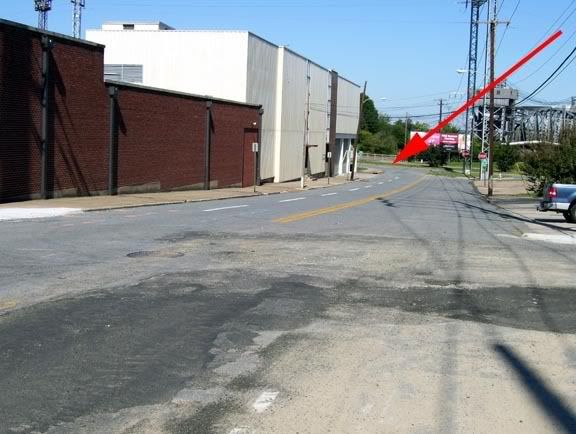
Here’s the approach, going south on Cross Street, to the Cantrell by-pass. A cyclist here will need to cross two lanes of oncoming traffic in order to enter onto the sidewalk so as to properly follow the bike path they’ve laid out. This leads to what is pretty much a blind corner, and riders crossing the oncoming lanes in order to get up on the sidewalk here are subject to a sharp surprise and a head-on collision with motor vehicles turning right from LaHarpe onto Cross Street. In this case, the cyclist is made to ride the wrong way directly into oncoming traffic, placing him or her at fault in the case of a car-bike collision.
Note that the pavement here is none too good either, (inviting a fall hazard) but that’s another issue for another day.
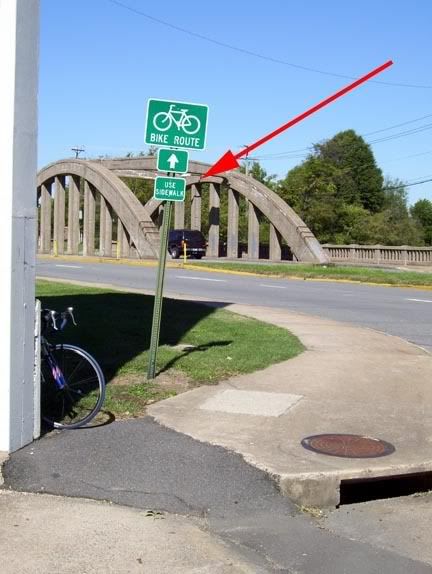
Here’s a close-up of the actual turn you have to negotiate once you get on the sidewalk, with the traffic sign indicating the bike path follows the sidewalk. Once here, you’re now violating two traffic rules: 1) you’re riding on the sidewalk, and 2) you’re going the wrong way against oncoming traffic.

This is a view of the bridge/overpass crossing the Union Pacific rail line, with a bike shown for size comparison to show how narrow the space is There’s room only for one-way traffic, whether a bike or a pedestrian, since the sidewalk is only a little wider than your handlebars. The adjacent (and oncoming) traffic lane is narrow, too, so you’re going to be pretty (and uncomfortably) close to the cars coming the other way, and there’s little room for error… and an 8-inch drop from the sidewalk to the street, if for any reason you might have to leave the sidewalk.
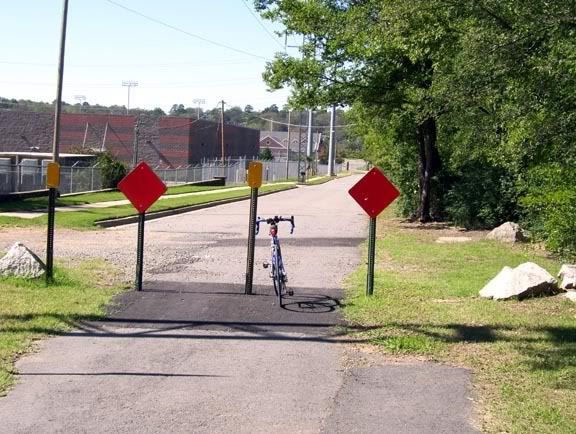
Immediately after crossing the bridge, you make a sharp, 90-degree left turn down a roughly paved, steeply inclined path (often gravel-strewn). At the bottom of this hill, you need to thread the needle between these signs, placed to mark the end/beginning of North Street, in front of the Episcopal School. (This is the little stretch that they want to close to build the new elementary school in this space.) Again, a road bike is shown to show the comparative narrowness of this hazard. Making it more interesting, this chokepoint is usually strewn with loose gravel, both from the adjacent railroad bed and the debris that piles up at the end of this otherwise dead-end street. The gravel makes it easy to lose traction and skid, or if you hit a big enough rock, you can flat a tire or suffer a diverting fall should you lose control of your front wheel.
Brad Joseph was injured in a fall here back in August, so it’s a real hazard to cyclists.
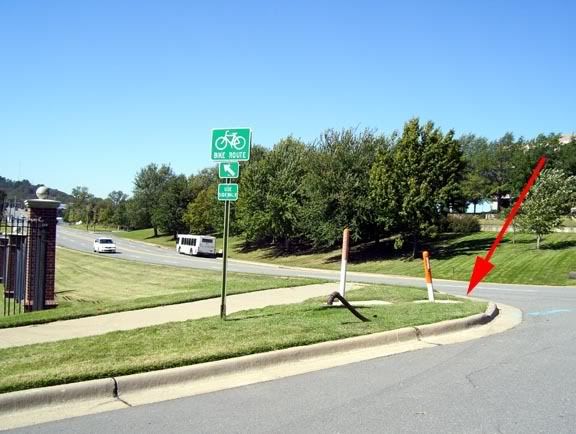
Exiting North Street and coming back onto Cantrell/LaHarpe, the bike path signs direct you back onto the sidewalk running in front of the Episcopal School campus. The only curb cut made so that you can get onto the sidewalk here without bunny-hopping over the curb and grass is just at the edge of the street, where the red arrow is pointing. Note again the green bike path sign, “USE SIDEWALK.”
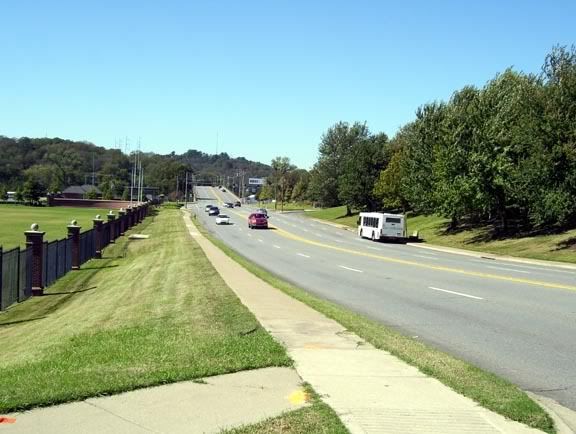
This view looks down the sidewalk/”bike path,” showing how narrow it is… again, this is suitable for one-way traffic only, and unsafe for simultaneous bike/pedestrian use. Fortunately, a good deal of the east-bound cyclists use their judgement as to the “usability” of the bike path, and ride the right-hand lane of Cantrell on up the hill past Dillards and the overpass, and simply turn right off LaHarpe onto Cross Street to pick back up on the bike route.
While you’re going westbound here, you’re back into traffic and safety violations, by 1) riding on the sidewalk, and 2) riding the wrong way against traffic.
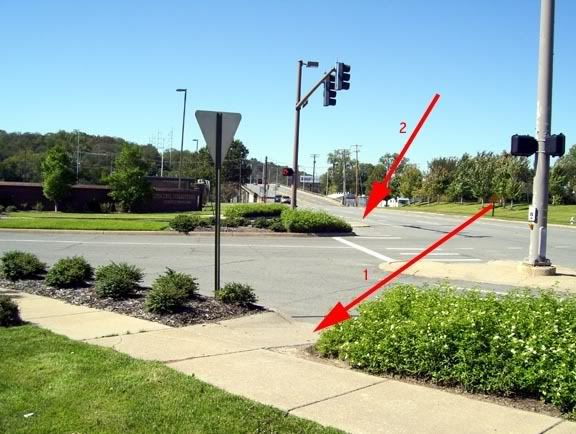
A little more than halfway down the sidewalk, you have to negotiate the driveway leading into the Episcopal School campus, which is designed only for vehicle or pedestrian traffic, not bicycles. Again the only curb cut involves a very sharp, very short right turn into the exit lane (Arrow #1), then you have to get past the decorative island in the center (Arrow #2). The only way to do this is to go around the island to the right in the oncoming traffic lane, or do a U-Turn back toward the gatehouse to go find the single curb cut letting you back on the sidewalk on the opposite side of the drive. Both options take the rider the wrong way into potentially oncoming traffic – violation of both traffic law, and safe practices.
The curb cut on the west side of the drive is easily missed... so unless you can bunny-hop the curb and grass strip, this could put you to riding down the left side of the traffic lane, also the wrong way against traffic, in order to get to the next obstacle.
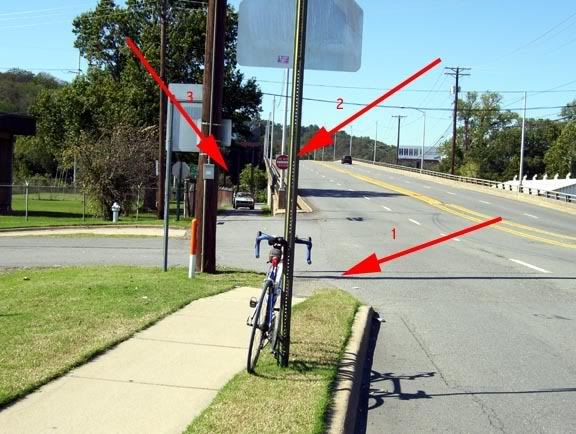
At the end of the Episcopal School property, the sidewalk abruptly ends, and puts the rider onto the shoulder of Cantrell Road, again on the wrong side riding into oncoming traffic (Arrow #1). To continue on the path, riders are directed down an alley way to the left of the Cantrell overpass and under the bridge, eventually emerging onto Gill Street, the road running in front of the warehouses on the north side of Cantrell near Junior Deputy Park. Please note that you’re being directed to ignore the “Do Not Enter” sign on this alley way (Arrow #2); and that there’s a good chance of running into oncoming traffic exiting the alley (Arrow #3) with no place to go…
Most of the most frequent complaints about local cyclists is that we ignore traffic law way too often… but then one of the most frequently-used bike paths has the City directing cyclists to violate some of the most basic safety principles… You should always ride on the right side of the road, never on the left against traffic. Wrong-way riding is the most-frequent cause of car-bike collisions and dead or maimed cyclists – accounting for 14% of all car-bike collisions, and you should never ride on the sidewalks. Cyclists ride on the road or street, where they’re mostly safe from pedestrians (who account for a little more than 1% of all bike accidents).
It may sound like a small thing in order to have connection between the two ends of the Trail amid two non-cooperative landowners, but what we’re doing here with the current work-around is reinforcing exactly the type of behavior that we need to be working against.
So... remember… y’all be careful out there. It would be nice to have a few more signs around like this one:


No comments:
Post a Comment